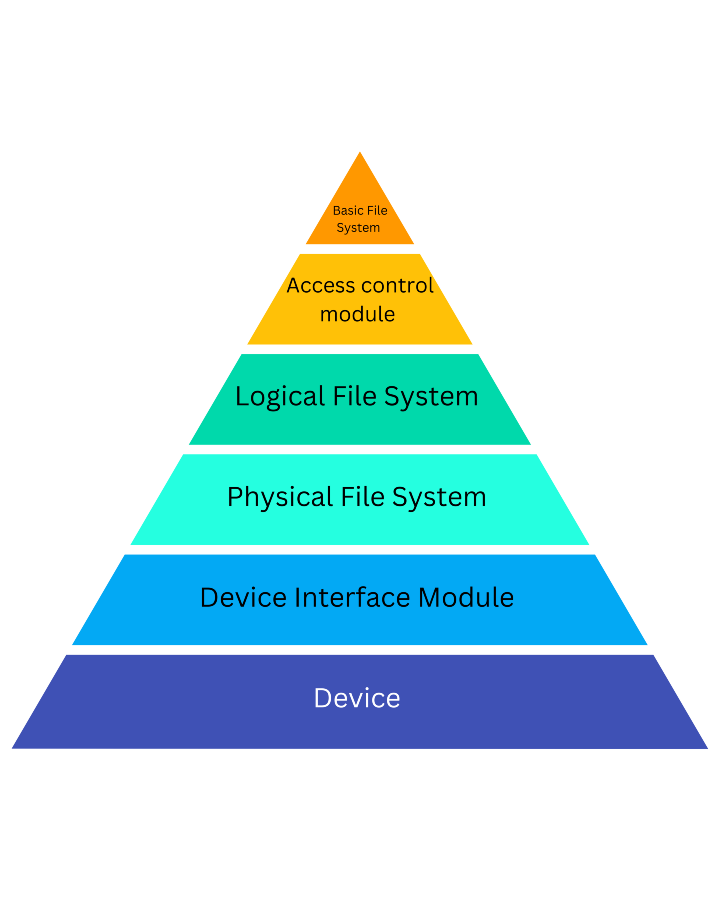
 Data Structure
Data Structure Networking
Networking RDBMS
RDBMS Operating System
Operating System Java
Java MS Excel
MS Excel iOS
iOS HTML
HTML CSS
CSS Android
Android Python
Python C Programming
C Programming C++
C++ C#
C# MongoDB
MongoDB MySQL
MySQL Javascript
Javascript PHP
PHP
- Selected Reading
- UPSC IAS Exams Notes
- Developer's Best Practices
- Questions and Answers
- Effective Resume Writing
- HR Interview Questions
- Computer Glossary
- Who is Who
Levels in a File Management System
File management is an important aspect of computer use, especially as we rely more and more on digital storage to keep track of important data. A file management system assists users in organizing and managing their files, making it easier to find, access, and modify data as needed. The system is typically organized into three levels: file level, directory level, and disc level. Each level is critical in file management and necessitates careful attention to ensure that files are organized, accessible, and secure. Effective file management can boost productivity, save time, and lower the likelihood of data loss.

In a File Management System, there are typically three levels of organization ?
File Level ? Individual files are managed at the file level, which includes creating, deleting, renaming, copying, and moving files. This is the most fundamental level of organization in a file management system, focusing on individual files. To keep related files together, files can be organized into folders or directories, and files can be sorted by name, size, date, or other attributes to make them easier to find.
At this level, some common file management tasks include ?
Users can either create new files from scratch or copy existing files as a starting point.
File deletion ? Users can delete files that they no longer require or want.
File renaming ? Users can rename files to make them easier to identify or to correct a mistake.
Copying files ? Users can make a copy of a file to use elsewhere or as a backup copy.
Users can move files from one location to another to reorganize their files or free up space on a specific drive.
Searching for files ?Users can look for files by name, type, size, or other criteria.
Directory Level ? Directories or folders are organized into larger directory structures at the directory level. This level of organization focuses on directory management rather than individual file management. Directories can be used to organize files by category, such as work, personal, or school, or to group related files together.
At this level, some common directory management tasks include
New directories can be created by users to help organize their files.
Users can delete directories that they no longer require or want.
Directory renaming ? Users can change the name of a directory to make it easier to identify or correct an error.
Copying directories ? Users can make a backup copy or a copy of a directory to use in another location.
Users can move directories from one location to another to reorganize their files or free up space on a specific drive.
Managing directory permissions ? Users can set directory permissions to control who can access, modify, or delete files within the directory.
-
Disk Level ? The entire disc is managed at the disc level. This level focuses on disc space allocation, deallocation, and disc maintenance tasks like disc formatting, partitioning, and backup.
At this level, some common disc management tasks include ?
Disk formatting ? Users can format discs to make them ready for use or erase all disc data.
Partitioning discs ? Users can divide a single disc into multiple partitions to organize data or make different types of files easier to manage.
Backing up discs ? Users can make a backup of their disc to protect themselves from data loss in the event of hardware failure, viruses, or other problems.
Disk space management ? Users can monitor the amount of space used on a disc and, if necessary, take actions to free up space
Conclusion
A document organization system is a computer tool for dealing with and organizing files. In accordance with this article, this file management system is divided into three categories: the file level, the directory level, and the disc level. Each one of these tiers is critical in managing files and must be carefully considered. This occurs so that files can be kept structured, readily available, and secure. Thus, by managing files, directories, and discs effectively, we can boost output, save energy, and decrease the risk of data loss. As a result of this, we are able to determine that a well-organized, successful, and maintained proper management of the files system is a necessary component for an effective and productive computing environment.

